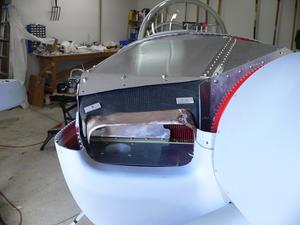The last couple of weeks have been fairly busy, as I was on course for several days, which required some studying in the evening. And I had to take care of a few things on the Honey Do List.
In my spare time, I've knocked a few items off the To Do List, and added a few more, for a new change in length of the list of about zero. I've been flailing away on the interface between the cowling and the plenum chamber. I'm making progress, but each time I mentally tell myself that I have turned the corner, and all the hard work is done, I run into another snag. I've had to back up and change course several times, but I am slowing grinding closer to the end for the right side. I won't start the left side until the right side is nailed down, but I expect the second side should go much quicker than the first one.
I've already decided that I should have used a different type of fastener for the plenum chamber. At the moment it is held in place with about 40 #8 screws, which will take some time to remove and reinstall every time I want to inspect the engine. I should have used some sort of quarter turn fastener, but I won't make that mod now. That'll be a change I make after I get flying.
 The basic concept is a strip of aluminum that will be riveted in the inside of the upper cowling inlet. A fibreglas transition piece will attach to that strip with three screws, and a long piece of inner tube rubber will go from there to the plenum chamber. This should provide a relatively good seal, while allow for motion between the plenum chamber (which is fastened to the engine) and the airframe. The sides of the rubber seal will be fastened to the vertical pieces of the plenum chamber sides, and the top will attach with four screws to the top of the plenum chamber. The edges of the inner tube will be sandwiched between pieces of aluminum sheet. The rubber inner tube pieces and fibreglas transition piece will remain in place when the plenum chamber top is removed.
The basic concept is a strip of aluminum that will be riveted in the inside of the upper cowling inlet. A fibreglas transition piece will attach to that strip with three screws, and a long piece of inner tube rubber will go from there to the plenum chamber. This should provide a relatively good seal, while allow for motion between the plenum chamber (which is fastened to the engine) and the airframe. The sides of the rubber seal will be fastened to the vertical pieces of the plenum chamber sides, and the top will attach with four screws to the top of the plenum chamber. The edges of the inner tube will be sandwiched between pieces of aluminum sheet. The rubber inner tube pieces and fibreglas transition piece will remain in place when the plenum chamber top is removed.
 I'll be trimming the front part of the plenum side walls, as I only need enough material ahead of the aft edge of the rubber to provide structural support for the floor of the inlet.
I'll be trimming the front part of the plenum side walls, as I only need enough material ahead of the aft edge of the rubber to provide structural support for the floor of the inlet.